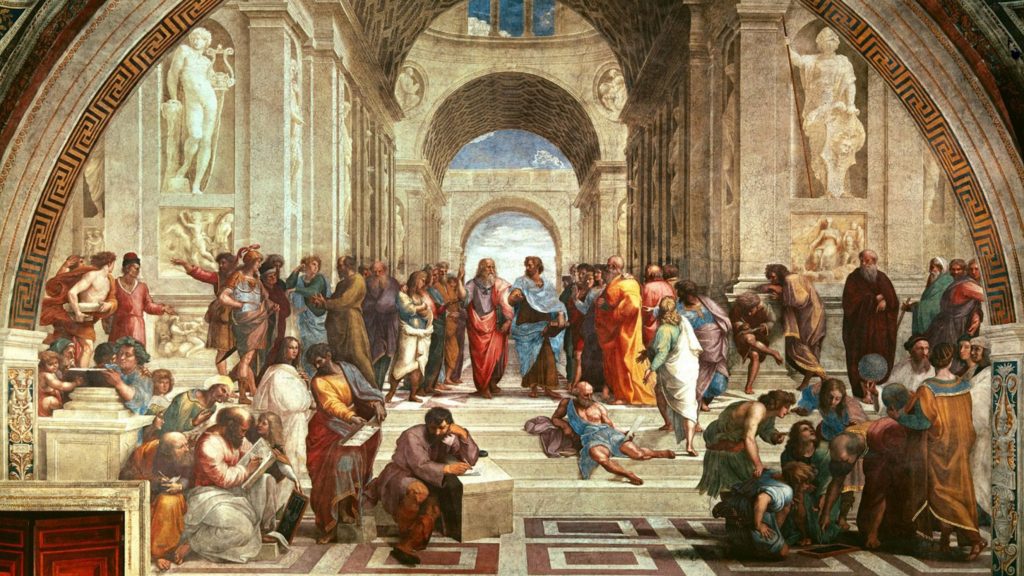
The School of Athens by Raphael
In 2013, I wrote a review of the excellent book, Common as Air by Lewis Hyde, about the history of the commons. I became interested in learning more about the history of “Civic Republicanism” while reading that book, which touches on the relationship of republicanism to pursuit of the common good. In later correspondence with Lewis, I asked for a recommendation on a good general book on the concept. He recommended Civic Republicanism by Iseult Honohan. So I picked it up from Amazon and it sat in my reading queue until recently. Now I’ve read it and it’s time to write a review.
To start off, let’s clear up some terms. A “republic” is likely a form of government you remember from high school or college. We’re interested in a particular type of republic known as a “Civic Republic” – that is, a form of government in which citizens rule themselves either directly or through representative leaders. If you live in the United States, you are familiar with the basics of a civic republic because it’s the system on which our country is based. It’s also important to point out that the terms republican and republicanism have absolutely nothing to do with the modern American right-wing Republican political party. When founded in 1854 by anti-slavery activists, the political party took its name from the idea of republicanism and originally advocated principles of republicanism and classic liberalism. Over the years it abandoned those principles, shifting right towards conservatism as the Democratic party shifted left towards modern liberalism. Eventually, the two parties reversed their original positions. More recently, the Republican political party seems to have broken into factions that advocate theocracy, plutocracy, or authoritarian nationalism. Ironically, republicanism is anathema to modern Republicans. The author is not an American and the book doesn’t address this difference between republicans and Republicans, which can lead to some confusion if the reader is unaware of it.
I read Civic Republicanism shortly after reading Steven Pinker’s enjoyable book, The Sense of Style. Unfortunately, this made me more aware than I might otherwise have been that Civic Republicanism is rife with examples of the problems Pinker describes in academic writing including “highfalutin gobbledygook”, overly abstract metaconcepts, and the curse of knowledge. It’s a hard book to read and definitely not an enjoyable way to pass the time. I found myself having to re-read paragraphs and sometime single sentences several times to work out what the author was trying to say. Here are a couple of random sample sentences from an early section of the book describing Aristotle’s views:
Because people are naturally undetermined as wholly good or wholly bad, but develop their character through acting, the social and political relationships in which they live are crucial to their possibility of self-realisation
and another
Moreover, the hierarchical division of human nature means that the obligations of citizens to anyone outside the political community are very limited.
Decoding 300 pages of that sort of writing takes a bit of work! That’s the bad news about the book.
The good news is that it does provide an excellent survey of the major historical thinkers on republicanism including Aristotle, Cicero, Machiavelli, Harrington, Rousseau, Wollstonecraft, and Madison (who designed our republic). It also covers modern political philosophers’ attempts to bring republicanism into the 21st century to compete with the currently more popular ideas of modern liberalism on the left (what we in the US might call “direct democracy” or “universal democracy”) and nationalism on the right (basically the modern Republican Party in the US – think flag waving, patriotism, belief in exceptionalism). The book is divided into two parts, the historical overview and the modern debates. The book does a good job of laying out the evolution of republicanism and points the way to all the original material if you have the time to pursue it.
The basics of a republic seem pretty simple. You get some people together, form a community, agree on rules for self-government and go to it. Generally, the goals are to maximize individual freedom while collectively pursuing common goods. If you want your republic to survive, it must have the qualities of civic virtue, political participation, personal and political freedom, equal political recognition, and equality of wealth. All the philosophers agree that a republic cannot survive long if there is corruption (a lack of civic virtue), lack of participation, or unequal distribution of wealth. So my earlier comment about the Republican political party having nothing to do with republicanism should be further clarified now. Their policy choices are a recipe for destroying a republic by maximizing wealth inequality and stamping out civic virtues.
Nothing is that simple of course and where our philosophers disagree is over the exact definitions of each of the desired qualities and the relative importance of each. For example, is freedom the complete lack of government coercion? To live in a community is to be interdependent on each other under the rule of law. But even if we make our own law, we must be subject to it. Does that limit our freedom or is the law an expression of our freedom? When Odysseus begs his crew to untie him as he listens to the siren song, does the crews’ lack of compliance indicate that Odysseus is not free? It was his own order that he be tied and that the crew refuse any plea to untie him until they are safely past the sirens. If citizens of a republic agree to jointly fund some common good through the collection of taxes, does being coerced later to fulfill that obligation represent a lack of freedom or an expression of the freedom?
Who should be counted as citizens of a republic? This was another question that evolved over time. Aristotle would have excluded women, slaves, young men, and many others. The circle of citizenship gradually expands with time. Eventually Wollstonecraft includes women, making republics encompass nearly everyone in time for Madison to pick up the idea and run with it.
What is the exact nature of civic virtue and corruption? Corruption as thought of in republicanism may seem non-intuitive to a modern reader. Today we think of corruption as a problem with politicians but in a republic, corruption is the problem of citizens who place their private interests above those of the common good or community interests, so political corruption is merely a subset of a larger problem. The citizen who avoids paying a fair share of taxes, who out of greed tries to influence politicians, citizens who avoid jury duty, voting, or participation in local government – those are the forms of corruption that will eventually destroy even the strongest republic.
What are the common goods that a republic should seek? There’s more agreement on this one. Common goods include building infrastructure such as roads, maintaining military strength for defensive purposes, providing universal education, and any other long term goals that are the will of the citizens and from which all citizens benefit such as protecting the environment, scientific research, universal healthcare.
The problem of wealth distribution is particularly interesting given our modern situation in the United States. Historical republicans from Aristotle to Madison would not be surprised to see the Occupy Wall Street movement given that corruption has resulted in so much of our nation’s wealth becoming concentrated in a tiny percentage of the population, a condition which is fatal to republics. For a good explanation of how wealth inequality became so severe in the US, see the excellent documentary by the economist Robert Reich called Inequality for All.
The sheer size of the Unites States would have presented problems to the earliest republicans, but not Madison. His improvements included the idea of a multi-level government that broke citizen participation into local, state, and federal levels. He added the concept that “representation” could be a partial substitute for participation in government among those who were incompetent to participate or merely apathetic. He dropped an idea held by earlier theorists that a republic needed a common religion or a religious test for participation in government, thus allowing a republic with the added freedom that a citizen could choose any religion or none. With these improvements, Madison hoped the United States could defy the expectations of earlier republicans that all large republics were doomed to fail.
Finally, how about a personal anecdote to take this from theory to practice.
On 23 May, 1745, an ancestor of mine, John Rainwater, went to the Edgecomb County, North Carolina court in order to record a deed. He came home having been appointed by the court to provide room and board to a fellow named John Jones who was overseeing the construction of a road through the county. It’s likely John Rainwater was appointed merely because of his presence in the court that day. Being a citizen of a republic who strove to exhibit civic virtue, he fulfilled his obligation because it promoted a common good from which he and others in his community would benefit. Can you imagine being asked to contribute towards a modern road construction project by hosting a construction foreman? We have little civic virtue left in this country. I have some conservative friends who believe what was once known as civic virtue is “government intrusion” on their freedom. They believe paying taxes is equivalent to the government taking their money (or even “stealing” their money). They not only wouldn’t be willing to contribute their time or money to building a road that benefits the community, they often actively oppose the very concept of the government pursuing any common good (e.g. roads, public schools, protecting our common environment).
Civic virtue remains as an idealistic goal for many but often a goal they hope someone else will achieve for them. Aristotle, Cicero, Rousseau, Wollstonecraft, Madison agree – all citizens in a republic should participate directly. Paying taxes is essential but not enough. Citizens need to learn how their government works and take part in it. Run for public office; volunteer for military service; take a civil service job; volunteer for a community board; join a CERT team; become a civic hacker. Today there are an endless number of ways to participate on many different levels of government.
I was inspired to join an Advisory Board in my hometown of Irving, TX. Coming from the business world, I had to adjust to the slower pace of government. But having been involved for over a year now, I’m beginning to see that what I’m doing is really making a difference. Ideas I’ve initiated have wound their way through city government and slowly taken effect. Here’s one way to look at it. If you’re like me, you’ve probably wasted hours of your life arguing politics online. No real change ever comes from those arguments. Instead, devote that time to learning about and participating in your local government. It’s a simple reallocation of your time that will result in less stress and real changes for the better.
 For the last two years, I’ve made Logic Cookies for the National Day of Reason. My first attempt in 2016 resulted in edible cookies but they had numerous problems including less than tasty cookies, soft icing that prevented stacking, and a sub-optimal cookie shape. I’ve patched up most of the issues for 2017 and succeeded well enough that it’s time to release the plans. The 2017 recipes are pretty standard sugar cookie and royal icing recipes with minor tweaks. I changed the cookie shape to hexagonal this year instead of circles. Hexagons are an ideal shape for Logic Cookies because the cookies can be cut with no wastage due to the ability to achieve a perfect 6.6.6 tessellation of the Euclidean cookie dough plane.
For the last two years, I’ve made Logic Cookies for the National Day of Reason. My first attempt in 2016 resulted in edible cookies but they had numerous problems including less than tasty cookies, soft icing that prevented stacking, and a sub-optimal cookie shape. I’ve patched up most of the issues for 2017 and succeeded well enough that it’s time to release the plans. The 2017 recipes are pretty standard sugar cookie and royal icing recipes with minor tweaks. I changed the cookie shape to hexagonal this year instead of circles. Hexagons are an ideal shape for Logic Cookies because the cookies can be cut with no wastage due to the ability to achieve a perfect 6.6.6 tessellation of the Euclidean cookie dough plane.







